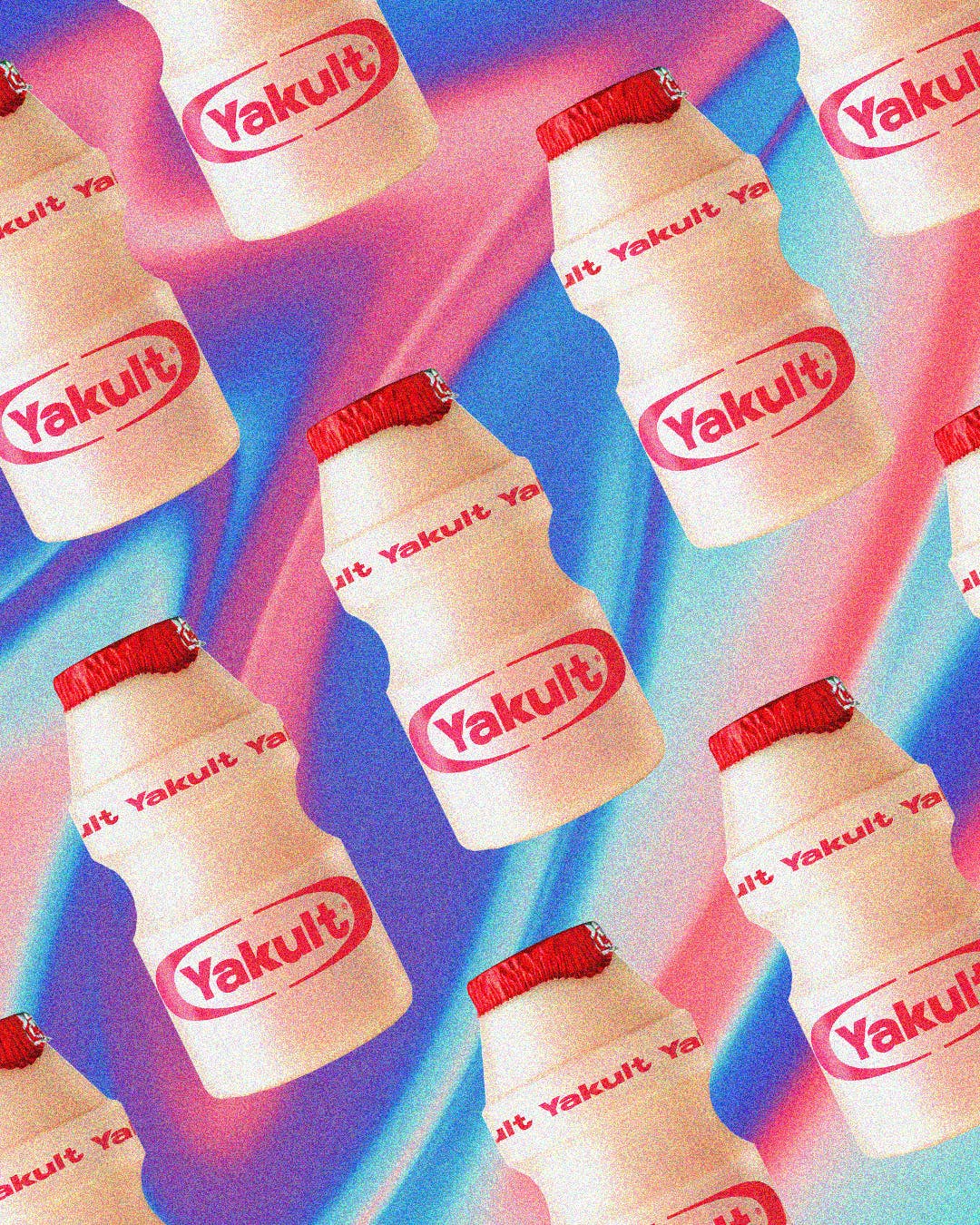Nothing Says ‘Asian American ‘90s Kid’ Like a Bottle of Yakult
Tangy, fruity, and subtly sweet, the Japanese probiotic was an AAPI staple in the 1990s—so why did it never go mainstream?

“I still drink Yakult for dessert. Actually, I drink five bottles in a row,” my Korean American roommate said proudly at dinner.
Every one of us—mostly Asian Americans—not only knew what Yakult was, but had an opinion on the drink. “Isn’t Yakult for kids?” a Chinese American friend asked. “I’ve heard it’s supposed to be healthy,” a Korean Brazilian friend mused, to the shock of my roommate and others, who were under the impression it was bad for you.
That night we’d been reminiscing about the roster of sweet treats we grew up on: creme-filled Hello Panda cookies, Hi-Chew candies, chocolate-dipped YanYan biscuits, Jin Jin lychee jellies, and—apparently the most polarizing—Yakult.
I couldn’t stop thinking about Yakult the following day and headed to New York’s Hong Kong Supermarket to see if it was still around. Would it taste like I remembered? Akin to kombucha or yogurt, it falls somewhere between dairy and citrus: milky smooth and sweet with fruity undertones. Fresh from the fridge, it was like liquid candy but with just enough tartness for balance. It struck me that Yakult was a singular beverage unto itself, and I began to wonder about its origins.
Yakult arrived in America in 1990 on the heels of an Asian grocery boom in the U.S. that brought us 99 Ranch, H-Mart, and Seafood City. As an Asian American kid growing up in the ‘90s and early 2000s, I was Yakult’s prime customer. It was one of the few beverages my local Asian grocery carried that wasn't tea or soda. Five-year-old me was as drawn to its flavor as to its adorable 2.7-ounce bottle capped with red foil that fit into my small hand. Two decades later, that packaging is so distinct in my memory that, standing in the refrigerated aisle of the grocery, I recognized the drink from afar and made a beeline for it.
Then I did something I’d never done as a kid: I looked at the nutrition label. The ingredients were: water, sugar, nonfat milk, glucose, “natural flavors,” and L. paracasei strain Shirota. That last one stood out—I later learned it was a unique strain of probiotic lactobacillus named after Dr. Minoru Shirota, the Japanese microbiologist who founded Yakult in 1935. The company has made small adjustments to the recipe over the years, but Shirota’s namesake bacterium has remained.
Yakult’s image as a health food brand explains, in part, why it’s been so successful. The company is valued at a staggering $2.8 billion and sells to more than 40 countries. (Comparatively, GT Living Foods, the largest kombucha brand in the U.S., is valued at just over $900 million.) The website recommends drinking one to two bottles daily as part of a healthy diet. And with buzzwords like “gut biome” and “probiotic” seemingly everywhere, the brand is well positioned to succeed in the U.S. So why hasn’t it caught on?
Yakult and kombucha are both probiotic beverages with Asian origins, but most of my non-Asian friends know only the latter. Perhaps that’s because kombucha’s Asian origins have been largely erased by the mainstream discourse. Kombucha arrived in the U.S. via Europe, where it got its first foothold outside of Asia. By the time companies like GT Living Foods and Health-Ade began producing kombucha Stateside, its image had already been “Westernized,” thereby avoiding the stigmas Asian foods have historically faced. By contrast, Yakult’s identity has remained firmly Asian—to its detriment in the U.S., where it is rarely sold outside Asian groceries. American sales of Yakult amount to 463,000 bottles per day, in comparison to 3,496,000 bottles in neighboring Mexico, where far fewer Asians live.
But Yakult found its U.S. market among Asian American kids like me who saw it on grocery store shelves and enjoyed it as a delicious, child-sized treat. The beverage became a subtle point of pride and identity that we could claim as our own—this distinctive bottle neatly packed in our lunchboxes.
These days, the beverage isn’t only in lunchboxes. Walking back from the grocery through Koreatown, I saw Yakult-flavored boba drinks, fro-yo, and soju on window signs and storefront menus. In recent years, Asian Americans’ nostalgia has given the beverage new life. The 2018 Netflix rom-com To All the Boys I’ve Loved Before featured the drink as a favorite of its Korean American protagonist, Lara Jean. Its few minutes on screen sparked memories that young Asian audiences took to social media to share—and even spurred a rise in the company’s stock price as the beverage sold out in stores. Yakult went on to appear in another Netflix film, The Half of It, and is frequently on the set of Korean dramas, which have found footing with Western audiences in recent years. These appearances in restaurants, movies, and pop culture continuously remind us that the Asian American kid of the ‘90s has grown up.
Nostalgia usually taps into a faraway past, yet for many Asian Americans, our history is intangible—across an ocean, in a different language, filtered through generations of a far-reaching diaspora. So instead, we seek to rebuild our own cultural history right here, where our past finds our present: in childhood anecdotes shared over dinner, in Asian groceries, and beneath the crinkly red cap of a bottle of Yakult.
Keep Reading
Continue to Next Story










